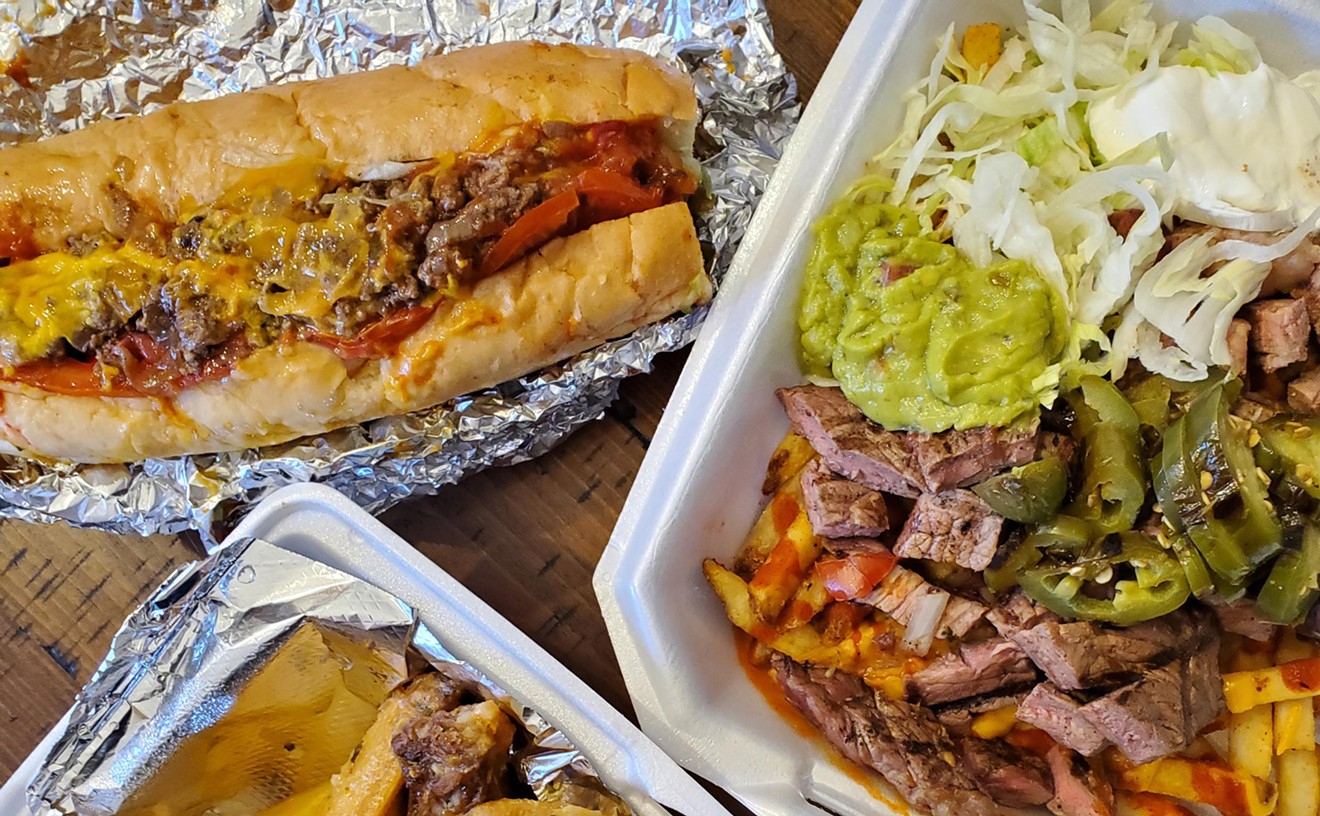This theory isn't her own invention. Grandma says she read about it somewhere, which could mean Ladies Home Journal or Cosmopolitan.
You would think that professional chefs would employ more scientific techniques to pull together their menus, but unless they happened upon my grandmother's method while researching ten ways to put the zing back into their marriages, they do the same thing everybody else does: They rely on memories of tastes, combinations that worked in the past and basic knowledge about what pleases the senses--like sweet with sour, squishy with crispy, red with green. At the Culinary Institute of America, incipient chefs take a course on menu planning that starts off with the most fundamental foods--rice timbales, vegetable purees, broiled meats and fish--and forces students to evaluate the pairings for flavor and visual effect. Only after they've mastered that can they move on to something more complicated...like actually cooking.
These days, though, chefs have access to a variety of weird new ingredients they never encountered in cooking class (remember the world before portobellos?), and they're often encouraged to break the rules in order to stay on the cutting edge. As a result, diners frequently are forced to swallow some silly things.
And that's the way the wind blows at Chinook Tavern, one of Cherry Creek's newest hot spots. Earlier this year, the Georg family took over the airy space that used to house Cache Cache--although you'd never recognize the place now. Manfred Georg, father and architect, gutted the dining room and decorated it with Colorado pine, colorful art and cheerful, antique-looking knickknacks. The room is bright, uplifting and comfortable, and probably the main draw for the crowds that pack the place, especially the large bar area, on weekends.
They certainly can't be there for the food. Although the ingredients are top-quality and often cooked with skill, the way they're put together is downright bizarre--as peculiar as the combinations of people you sometimes find at Chinook's upscale share table.
The menu is international in scope but has its foundation in the heavy-handedness of German cooking, with its focus on meat, cabbage and potatoes. The hands here belong to Markus Georg, Manfred's son, who left Germany with the rest of his family in 1976. Since then Markus has graduated from CIA and worked in numerous restaurants, including the Alpenrose in Vail and two of Germany's Michelin-rated restaurants.
His culinary background is readily apparent in the appetizer of sauteed shrimp cakes ($7.95), two large, almond-encased rounds of spicy chopped shrimp served atop a red-bell-pepper sauce. The sweetness of the sauce served to counteract the heat of the cakes, and after the shrimp was gone, it also worked well with the plate's smattering of mixed greens. It probably would have gone better with the house-cured Colorado trout ($6.95) than the Dijon mustard sauce that accompanied the fish; the sauce was so heavy with honey that it obliterated any taste of the trout. That may have been a blessing, though, because the fish had the texture and appearance of herring, with none of its flavor.
Chinook's kitchen exhibited that it does have some sense of balance when creating soups. The cream of leek ($2.95 for a cup) was a perfect blend of rich cream, tender leeks and pepper, which played up the onions and toned down the cream; the gazpacho ($2.95) mixed just the right proportions of cucumbers, tomatoes, onions and herbs in a thick tomato broth.
But then came the entrees. The beef roulade ($16.95) was really rouladen, the German preparation that pounds the meat thin and rolls it around vegetables, in this case thin sticks of carrot and pickle. Although a Cabernet Sauvignon sauce perked things up, it seemed an incongrous pairing with such a staid meat. A side of chunky garlic mashed potatoes--the tuber appears with nearly all of Chinook's entrees in one form or another--came ridiculously strewn with two baby carrots and a half-dozen green beans. The spuds reeked of garlic and covered half the plate; by the time I'd gotten through a third of the mountain, the rest of it had cooled and hardened until it practically required a pick ax for penetration.
More mashed potatoes arrived with a loin of lamb ($18.95) that had been marinated in rosemary and grilled. The rosemary was repeated in a strangely subtle sauce--strange because the herb is usually so pungent--that added nothing to the mediocre meat. The spears of fresh asparagus looked more like a garnish than the promised side--so bring on the potatoes! We could have built a replica of the Devil's Tower with what we left on our plates, but we didn't want to fill up on potatoes, because we'd heard about the chocolate bag ($4.75) that Markus makes for dessert. It actually looked more like a box than a bag, made of imported chocolate and filled with creme anglaise and mocha ganache. A ganache is an icing of chocolate melted into cream that can be whipped into a kind of mousse-textured souffle, as it was here; the mocha helped take the edge off this super-rich concoction. As good as that was, though, Markus's signature dessert turned out to be the rote gruetz ($4), a melding of sweet and sour cherries, boysenberries and raspberries that he cooks down with creme de cassis and drapes with creme anglaise. The final product was like a dessert jam, so thick and sweet it was hard to eat much--although we certainly tried.
If only everything on our second visit was as inspirational as the end to that first meal. Once again, the soup was a hit--an incredibly smooth cream of asparagus ($2.95) that was light yet filled with the vegetable's essence. But the kitchen stumbled with the bundnerfleisch ($6.95), nearly transparent sheets of salt-cured, air-dried beef inexplicably accompanied by a pigeon squirt of goat cheese, two oil-slicked mushrooms and a hailstorm of pine nuts. They did nothing for the gourmet jerky--and vice versa. At least the garlic mashed potatoes--no! Not again!--made a traditional German side for grilled sausages ($7.95), Chinook's trio of apple pecan, chipolata and smoked bratwursts. These wursts were the best: clean-tasting and not greasy, spruced up by a few caramelized onion slices.
Fortunately, spaetzle was the starch with another roulade, this time venison ($15.95) wrapped around a duxelles of shiitake mushrooms and roasted red bell peppers. Unfortunately, the plain spaetzle had the consistency of packing popcorn, and the venison didn't have enough Merlot sauce to share. But the meat itself was tender, and the mushroom stuffing had a potent earthiness that was offset by the wine. An order of sauteed duck breast ($16.95) brought four pieces of succulent bird in another Cabernet Sauvignon sauce (this one a little sweeter), decorated with a frightening splat of pea puree that made me wonder if they'd hired Linda Blair as sous chef. The menu had listed potato cakes, but the kitchen was out, and the waiter asked if I would like mashed. No way. Instead, I opted for the parsleyed organic new potatoes, nice and simple, an excellent example of Markus's commitment to someday getting all of Chinook's produce from organic farms in the area. The restaurant could singlehandedly support the entire Colorado potato industry.
But not with the grilled mushroom-crusted salmon ($14.95), which surprisingly arrived with a side of sauteed kale, not spuds. This relative of cabbage is normally a welcome change--but not when it's served with mushroom-crusted salmon. The hefty piece of fish, which was overcooked--possibly because it had been sitting under a heat lamp while our waiter flirted for fifteen minutes with a woman at the bar--was plopped on a creamy chervil sauce that had lost any hint of chervil. And don't ask me why, but the plate was rounded out by a piece of poblano corn bread.
For all of the kitchen's emphasis on experimentation--some successful, some disastrous--the most memorable thing I found at Chinook was a simple side of red cabbage, which Markus calls "Old World." The sweet-and-sour cabbage had been cooked to the ideal consistency--not crunchy, not mushy--and sparked by a touch of spice. Red (of course), it came with the meat (brown) and mashed potatoes (lots of white)...
Hey! Maybe Grandma is on to something. Send Chinook a subscription to Cosmo, with my compliments.










